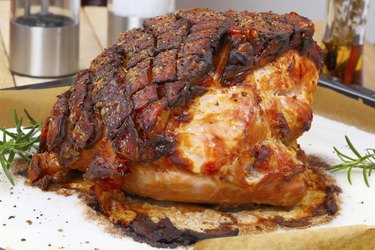
In its truest form, roasting means using high, dry oven heat to cook -- no supplementary cooking liquids needed. Preparations that include tough cuts of meat, including pork roast, almost always call for braising, and often unnecessarily. The addition of a cooking liquid combined with low oven temperature does produce a tender cut of meat. However, a braised pork roast lacks the all-over browning of roasted pork. And even if you sear the pork before you braise, half of it's still cooking in liquids, and that half will invariably have less caramelization than the other. Roasting gives pork character that braising can't.
Cut Selection
Video of the Day
In reference to a cut of meat, roast is a loose term, but you can consider any cut of pork weighing 2 or more pounds a roast -- the cut can originate from any muscle of the animal. You have several options to choose from, but there are a few in particular that stand out when oven roasted.
Video of the Day
Boston butt, or pork shoulder, has a lot of marbling and therefore a lot of flavor. It stays moist through roasting, and, for the money, is perhaps the best option for pork roast depending on your tastes.
Loin roasts have several market names indicating where they were cut from -- center-cut pork loin, pork loin rib half and pork center loin roast, to name a few. Don't let the names confuse you. All cuts from the pork loin are consistently lean and moderately tender, and stand up well to roasting -- if you don't cook them too long. Pork loin quickly dries out when its internal temperature goes above 145 degrees Fahrenheit.
Leg roasts are cut from the hindquarter. Typically used for ham, the leg makes a superb everyday roast -- its thick fat cap bastes the meat as it cooks, and it has a wealth of marbling. The leg also yields a bonus: The fat cap crisps as it cooks, rendering into a generous handful of salty cracklings.
Trimming
You need to trim all boneless pork roasts of nonessential fat and tie them.** Nonessential fat hangs off the roast in irregular shapes and adds nothing to the dish -- these are pieces the meat cutter missed. Trim these pieces off. If you're cooking pork leg, slice parallel slices 1/2-inch apart through the fat cap.
Seasoning
Seasoning comes in several forms. Marinades, spice rubs and herb crusts -- and of course kosher salt -- all constitute seasoning methods that work with pork roast.
Start with salt. Unless you're doing a marinade or spice rub, coat the pork roast with olive oil and liberally season it with kosher salt.
Make a basic pork marinade by mixing 1 part each vegetable oil and acid and flavor it to to taste with kosher salt and sugar. Add herbs and spices according to preference.
Herb crusts need to withstand the high heat of roasting, so lean towards herbs with hardy leaves, such as rosemary and thyme. Roughly chop 1 part hardy-leafed herbs and 2 parts parsley, and mix. Parsley mellows the flavors and adds volume. Coat the pork roast with a light layer of olive oil and pack the herbs on all sides. If you're roasting pork leg, leave the fat cap free of herbs.
The standard 4-3-2-1 spice combination provides the go-to mix for a balanced rub. Coat the pork in olive oil. Mix 4 parts kosher salt, 3 parts brown sugar, 2 parts paprika and 1 part cayenne pepper. Add one or two additional spices, such as garlic powder and cumin, to taste if desired. Pack the spice rub on all sides of the pork roast.
After seasoning or marinating, wrap the pork roast tightly in plastic wrap and let it sit in the refrigerator for a few hours to marry the flavors.
Tying
Pork roasts are naturally irregular in shape; pork loin often has one side thicker than the other, pork leg has a somewhat conical shape, and pork shoulder kind of looks like it's all over the place. Tying the pork roast crosswise at 1- to 1 1/2-inch intervals and, if necessary, once or twice lengthwise, helps produce uniform cooking throughout the meat.
Roasting -- Let's Get it On!
Searing is the first step towards a superior roast. Without browning the roast first, the fat won't crisp to cracklings, the exterior will have the same texture as the interior, and the flavor won't contrast between sharply caramelized and mellow. Start by taking the the roast out of the fridge and letting it warm up to room temperature for at least 30 minutes.
Heat the oven to 475 degrees Fahrenheit. Place the roast fat-side up in a shallow roasting pan. If you have a wire rack, set it in the pan and set the roast on it. Toss a few cups of mirepoix around the roast and place it in the oven on the center rack. Sear the pork roast until it develops a dark brown color, about 10 to 12 minutes.
Lower the temperature to 325 F. Roast pork loin for 22 minutes per pound; roast pork shoulder and leg for 25 minutes per pound. Cover the roast with aluminum foil if you see the top getting too brown.
Pork roasts measure 145 F in the center when fully cooked.